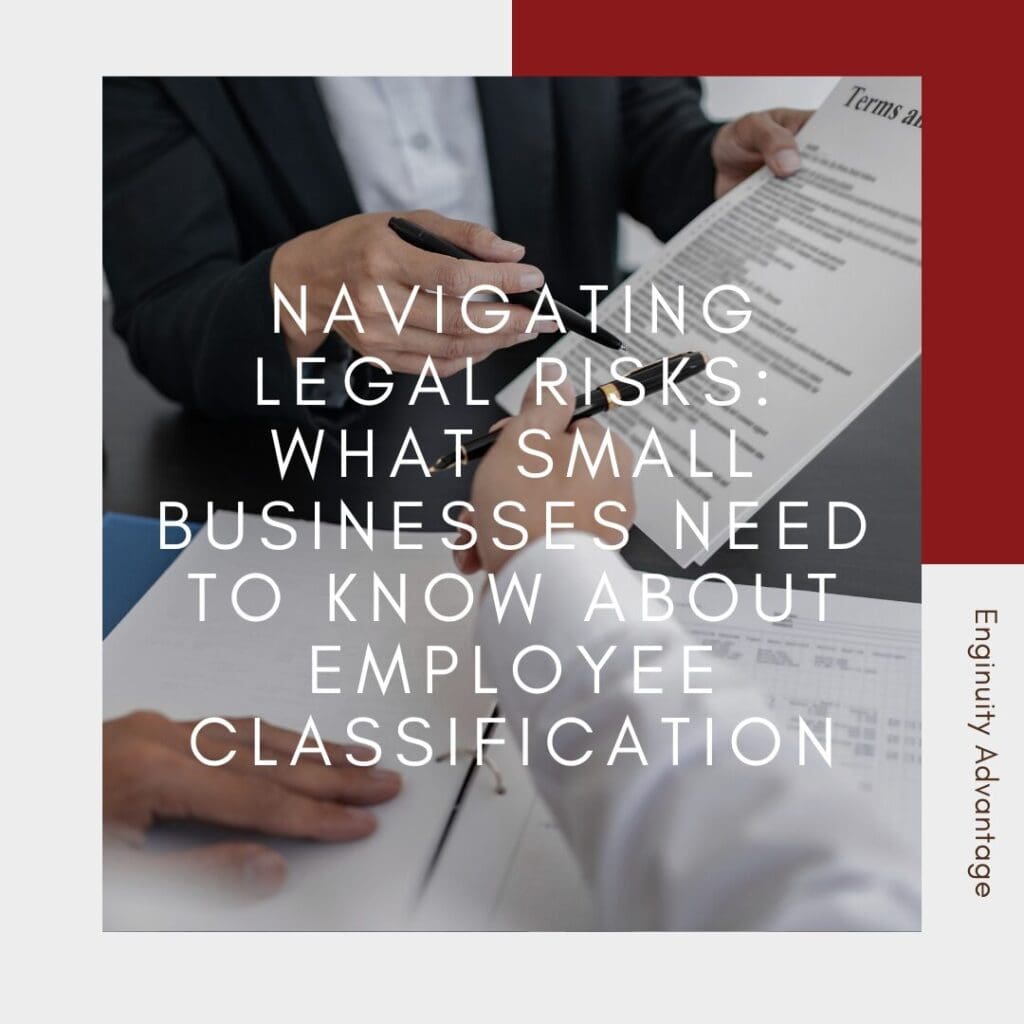Navigating Legal Risks: What Small Businesses Need to Know About Employee Classification

Employee classification is one of the most critical legal considerations for small businesses. Misclassifying employees can lead to severe financial penalties, tax liabilities, and legal disputes. Understanding the distinctions between employees and independent contractors, exempt and non-exempt employees, and the laws that govern these classifications is essential for business owners looking to stay compliant while managing their workforce effectively.
Understanding Employee vs. Independent Contractor Classification
A common challenge for small businesses is determining whether a worker should be classified as an employee or an independent contractor. Employees typically work under the direct control of the employer, receive benefits, and have taxes withheld from their paychecks. Independent contractors, on the other hand, operate as self-employed individuals, have more autonomy over how they perform their work, and are responsible for handling their own taxes.
Misclassification of workers as independent contractors instead of employees can lead to costly penalties imposed by the IRS, Department of Labor (DOL), and state labor boards. Employers must evaluate factors such as the level of control over the worker’s schedule, the provision of tools and equipment, and the permanence of the working relationship to ensure proper classification.
Additionally, businesses should review industry-specific regulations that may further define independent contractor classifications. Some states enforce stricter interpretations of employment laws, making it critical for companies operating across multiple jurisdictions to be well-versed in regional labor laws.
Exempt vs. Non-Exempt Employees
Another critical classification issue involves exempt and non-exempt employees under the Fair Labor Standards Act (FLSA). Exempt employees are not entitled to overtime pay and typically hold executive, administrative, or professional positions. Non-exempt employees, on the other hand, must receive overtime pay for any hours worked beyond 40 hours per week.
Failure to properly classify employees as exempt or non-exempt can result in wage and hour violations, leading to lawsuits, back pay requirements, and fines. Employers should regularly review job descriptions, salaries, and work duties to ensure compliance with federal and state labor laws.
Key Legal Risks of Employee Misclassification
Employee misclassification can result in severe legal and financial consequences for businesses. Government agencies actively audit companies to ensure compliance with tax and labor laws. Penalties for misclassification can include back wages, unpaid overtime, tax penalties, and liability for employee benefits such as health insurance and retirement contributions.
Additionally, misclassification can expose businesses to lawsuits from workers who claim they were denied proper wages or benefits. High-profile cases have shown that companies that misclassify workers—whether intentionally or unintentionally—face costly settlements and reputational damage. Employers must be proactive in reviewing their employment practices and making adjustments before legal actions arise.
Navigating State and Federal Employment Laws
Small businesses must navigate both federal and state employment laws regarding worker classification. While the FLSA and IRS guidelines provide a federal framework, states often have stricter standards that businesses must follow. California’s ABC Test, for example, makes it more difficult for businesses to classify workers as independent contractors by requiring proof that the worker operates independently and outside the employer’s usual course of business.
State-specific employment laws can vary significantly, meaning that multi-state businesses must ensure compliance in each jurisdiction where they operate. Keeping up with these laws requires ongoing research, legal guidance, and proactive workforce management strategies. Additionally, local labor laws may impose specific requirements on worker protections, benefits, and classification reviews that businesses must comply with to avoid penalties.
Best Practices for Employee Classification Compliance
To avoid legal risks and costly penalties, small businesses should implement best practices for employee classification compliance. Conducting regular internal audits to review worker classifications, maintaining accurate records of job duties and work agreements, and consulting with legal or HR professionals are essential steps to ensure compliance.
Employers should also provide training to HR personnel and hiring managers on classification rules and legal risks. Clear, documented policies outlining job responsibilities, payment structures, and work expectations help protect businesses from potential disputes and regulatory scrutiny. Having a proactive compliance program in place ensures that worker classification remains accurate and up to date as business needs evolve.
How to Correct Misclassification Issues
If a business discovers that it has misclassified employees, taking immediate corrective action is crucial. Employers can work with tax professionals or legal advisors to reclassify workers appropriately, pay any back wages owed, and ensure compliance moving forward. In some cases, voluntary classification settlement programs (VCSPs) offered by the IRS can help businesses reduce penalties for misclassification errors.
Correcting misclassification proactively demonstrates a commitment to legal compliance and can help mitigate potential legal consequences. Businesses that take steps to address classification mistakes before audits or lawsuits occur can avoid more significant financial and reputational damage. Implementing preventative measures, such as updated job descriptions and classification training, can further reduce the risk of future misclassification errors.
The Role of HR and Legal Teams in Employee Classification
Human Resources (HR) and legal teams play a crucial role in ensuring that employee classification remains compliant with labor laws. HR professionals should conduct thorough onboarding processes that clearly define employment status, regularly update employee handbooks, and stay informed about changing regulations.
Legal teams, whether in-house or external consultants, can provide guidance on classification issues and represent businesses in legal disputes if necessary. Partnering with professionals who specialize in employment law ensures that businesses make informed decisions regarding worker classification and compliance strategies. Proactive collaboration between HR and legal departments can also help create clear policies that prevent disputes from arising.
The Future of Employee Classification Laws
Employee classification laws continue to evolve as new workforce trends emerge. The rise of the gig economy, remote work, and alternative employment arrangements has prompted ongoing legal debates about worker rights and employer responsibilities. Businesses must stay ahead of these changes by monitoring legislative developments, industry best practices, and court rulings that may impact classification requirements.
Anticipating changes in employment laws allows small businesses to adapt their workforce strategies and avoid compliance pitfalls. Staying proactive in classification compliance will help businesses operate smoothly while avoiding costly penalties and legal disputes. As technology and workforce dynamics shift, small businesses must be prepared to reassess their classification processes and update policies accordingly.
Protecting Your Business from Classification Risks
Understanding and properly applying employee classification rules is vital for small businesses looking to avoid legal risks and financial penalties. By correctly distinguishing between employees and independent contractors, ensuring compliance with exempt and non-exempt classifications, and staying updated on employment laws, businesses can protect themselves from regulatory scrutiny.
Implementing best practices, conducting regular audits, and seeking legal guidance when needed can help small businesses navigate the complexities of employee classification. Taking a proactive approach ensures compliance, minimizes legal exposure, and fosters a stable and legally sound workforce. With the growing complexity of employment laws, small businesses must stay ahead of evolving regulations to safeguard their operations and maintain strong workforce relationships.
Unlock Dream Careers & Elite Talent: Just One Click Away!


